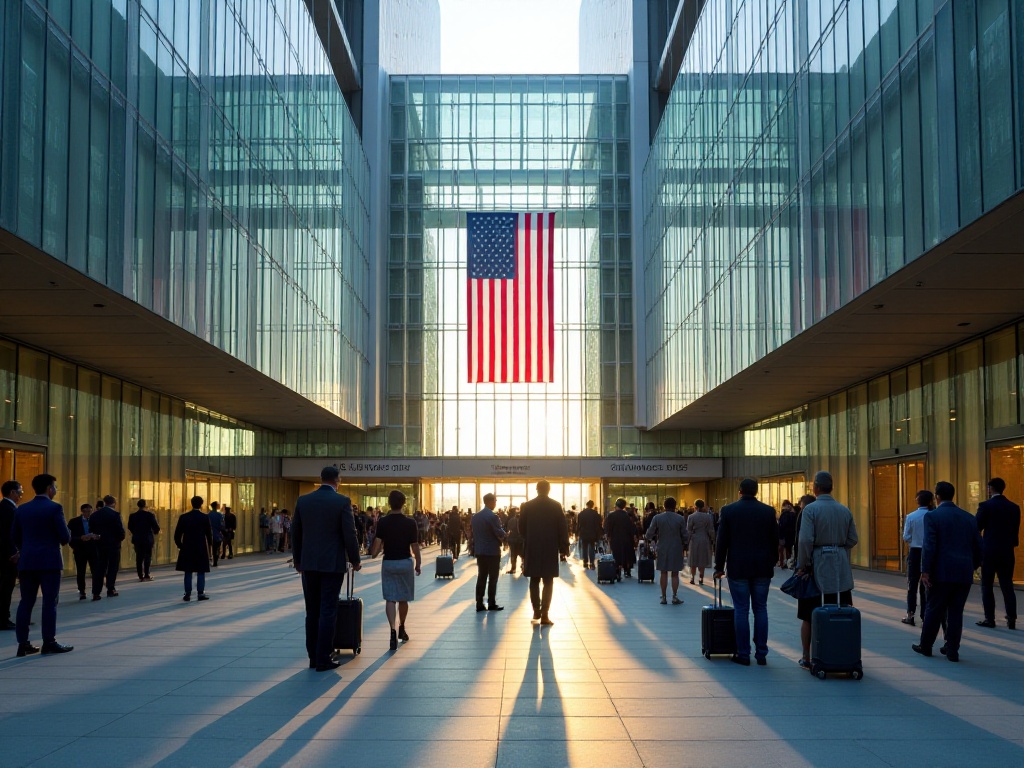Getting Straight to the Point
Friends, today I want to share an extremely practical topic - US visa application. As someone who has gone through three US visa applications, I can say I've experienced the pitfalls and climbed the slopes, finally figuring out the ins and outs. Honestly, whenever I see people sharing their visa rejection experiences online, I deeply empathize. Do you know? The number of visa applicants each year is staggering - in 2023 alone, over 14 million people were waiting for visas! And about 15% of them were rejected due to various unexpected details, which is truly a sobering number.
Visa ABC
Many people get a headache when they hear about visa applications, thinking it's particularly troublesome. But I want to tell you that a visa is just a "pass" - nothing scary about it. It's like when you want to visit someone's home, you need to give advance notice and get an invitation, right? The US visa system is quite interesting; they divide visas into two main categories: one is the non-immigrant visa for temporary visits and business, like visiting a friend's house; the other is the immigrant visa for those who want to settle in the US, which is like moving into a new house for long-term residence.
Speaking of non-immigrant visas, they are further divided into many types. For example, there's the F-1 visa for international students, J-1 visa for exchange visitors, and H-1B visa for business professionals, etc. Each type of visa has its specific application conditions and uses, like different keys that need to be used in the right place.

Choosing the Right Visa
For ordinary people like us, the most common and easiest to apply for is the B-class visa. It comes in two types: B-1 business visa and B-2 tourist visa. The B-1 visa is mainly for those who need to attend business meetings, negotiate business, or attend exhibitions in the US; the B-2 visa is for those who want to travel, visit relatives, or seek short-term medical treatment in the US.
Interestingly, US consulates now generally issue B-1/B-2 combination visas to applicants, which is much more convenient. For instance, if you're traveling for leisure this time, and have business needs next time, you can use the same visa without reapplying - how thoughtful! Moreover, these combination visas are usually valid for ten years with multiple entries, meaning you can go as many times as you want during the validity period, depending only on your time and financial resources.
I remember being quite worried during my first application, fearing I might choose the wrong visa type. Later I learned that the US embassy staff are very professional - if your application type is incorrect, they will help adjust it for you. This point really touched me, as there's no need to worry about making mistakes.

Warning Signs
At this point, I must remind everyone of an extremely important issue - the boundaries of visa usage. Many people think they can do whatever they want after getting a visa - this is a huge misconception!
Let me give you some specific examples. For instance, if you're in the US on a B-class visa, even if you receive an attractive job offer, you cannot accept it. B-class visas do not allow you to engage in any paid work in the US, not even part-time or temporary work. I know a friend who helped out at a restaurant for a few days to earn some pocket money while touring the US, but was reported. As a result, not only was their visa revoked, but they were also blacklisted - truly not worth the risk.
Also, you cannot use a B-class visa to formally attend classes at US schools. Although you can visit schools and audit courses, if you want to earn credits or obtain a degree, you must apply for a student visa. I've heard of people trying to find loopholes by enrolling in short-term vocational training programs, only to be deported by customs upon entry.
Even more extreme, I know of some art groups who performed in the US under the guise of tourism, and even charged fees. This behavior is like playing with fire! Once discovered, it not only affects personal visa records but might also implicate the entire group. So I urge everyone, never try to test these red lines with a fluke mentality.

Application Strategy
Regarding the application process, there are endless nuances to discuss. I suggest everyone must proceed step by step and never rush. First is preparing materials, which is particularly important - I think it could even be called the key to success or failure.
Everyone knows to prepare their passport and DS-160 form for basic materials, but there are many details that need attention. For example, with passports, you not only need to ensure sufficient validity (recommended at least one year remaining), but also make sure there are enough blank pages. I've seen people try to apply with nearly expired passports, only to be asked to get new ones first, wasting an interview opportunity.
Filling out the DS-160 form is also an art. This form has about a dozen pages, covering everything from personal information to work experience, travel plans to family status. I suggest everyone must be extra careful when filling it out, as all this information will be recorded, and consular officers will also ask questions based on this information during the interview.
Speaking of proving financial capability, this is absolutely crucial. According to US State Department statistics, over 25% of visa rejections in 2023 were due to applicants being unable to prove sufficient financial resources. So I recommend preparing bank statements from the past six months, fixed asset proof (such as property certificates, vehicle registration, etc.), and proof of stable employment (labor contracts, pay stubs, social security records, etc.).
Moreover, it's best to prepare both originals and copies of these materials. Although they might not be needed during the interview, it's better to be prepared. During my second application, it was because I was well-prepared that when the interviewing officer asked about income, I could immediately produce pay stubs and bank statements, making the entire interview process very smooth.
Operational Details
Online form filling can be considered a technical skill. First is the DS-160 form, which is actually designed quite user-friendly - you can save your progress at any time without needing to complete it all at once. But there are several places where mistakes are easily made, let me give you a heads up.
For instance, in the personal information section, the pinyin of Chinese names must exactly match what's on your passport, including spaces and punctuation marks. Also for address filling, whether it's current residence or permanent address, try to be as detailed as possible, preferably down to the door number. The work information section is also important - company names and addresses must be accurate as this information might be verified.
The photo issue can be really troublesome. US visa photo requirements are particularly strict - must be within six months, must have pure white background, no glasses (unless for medical purposes), natural expression, and correct head position. I suggest going to a professional photo studio to take the picture, although it might cost 50-100 yuan, at least it ensures compliance. I know a friend who used a self-taken phone photo that didn't meet requirements, and had to retake photos on interview day, not only wasting time but also affecting their mood.
There are many tricks to scheduling interviews as well. Currently, the wait times for interviews at US embassies and consulates in China are quite long, generally between 200-400 days. So I suggest everyone plan well in advance - for example, if it's for tourism, consider seasonal factors; if it's for business, coordinate with conference or exhibition times.
Moreover, you can now schedule interviews through a mobile app, which is particularly convenient. You can check interview scheduling situations at various embassies and consulates at any time, and if someone cancels their appointment, you can fill the slot immediately. During my third application, I used this method - originally had to wait over 300 days, but caught someone's cancellation and moved up by two months.
Interview Preparation
The interview is absolutely the most nerve-wracking part of the entire visa application process. But I want to tell everyone there's no need to be too nervous, because interview officers are regular people too, and they mainly want to confirm two points: whether your purpose for visiting the US is genuine, and whether you have the intention to return on schedule.
From my experience, interviews usually take just 5-10 minutes. The officer will ask a few questions based on your DS-160 form, such as what you'll do in the US, how long you plan to stay, where you'll stay, etc. These questions aren't actually difficult to answer - the key is to be honest and confident.
I suggest everyone prepare a self-introduction before the interview, explaining your basic situation in simple English. For example, what work you do, roughly how much monthly income you have, and what your specific plans are for this US trip. This information should be conveyed in three to four sentences, as the interview officer's time is precious too.
Also be prepared to handle some possible questions. For instance, if the officer asks why you chose this time to visit the US, you should be able to give reasonable reasons; if asked about your itinerary in the US, you should be able to outline it roughly. Of course, no need to prepare too much detail, as being overly detailed might seem unnatural.
I remember being extremely nervous during my first interview, my palms were sweating. But once the interview actually started, I found the officer was very friendly and the questions were all basic. As long as your answers are sincere and your attitude is positive, there generally won't be any problems.

Global Perspective
At this point, some might ask: are visas for other countries this complicated too? Not necessarily. Now nearly 60 countries and regions offer visa-free or visa-on-arrival policies for Chinese citizens - this is great news!
For example, Morocco began implementing a visa-free policy for Chinese tourists in 2023, exciting many who want to visit the "Sahara Desert" and the "Blue City of Chefchaouen". Also, tourist destinations like the Maldives and Fiji offer visa-on-arrival with very simple procedures.
However honestly, although the US visa application process is relatively more complex, once you get a US visa, it becomes much more convenient for global travel. Many countries recognize US visas, allowing visa-free entry or simplified visa procedures for US visa holders. This is an unexpected bonus!

Friendly Reminders
Finally, I want to specially remind everyone of several points. First, even when going to visa-free countries, you must ensure your passport validity exceeds 6 months. This requirement can be said to be an international standard. I've seen people embarrassingly stopped at airports because their passports didn't have enough validity.
Second, regardless of which country you're visiting, prepare round-trip tickets and accommodation proof. These are basic documents checked upon entry. I suggest printing these documents, because sometimes phone signals might be poor or batteries might die, making electronic versions inaccessible.
Third, I recommend getting travel insurance before departure. Although not mandatory, if you encounter any unexpected situations abroad, having insurance at least gives you less to worry about. I have a friend who sprained their ankle while traveling in the US - fortunately they had insurance, and all medical expenses were reimbursed.
Concluding Thoughts
Through these years of experience, I increasingly feel that applying for a visa is actually a process of demonstrating your credibility. It's like a mirror, reflecting your personal credit and sense of social responsibility. As long as you prepare thoroughly and maintain a sincere attitude, visas aren't as scary as imagined.
Moreover, I think the visa application process is also a learning and growth process. Through this process, you'll learn how to better plan your itinerary, how to handle various documents more professionally, and even improve your English speaking skills. This experience will be very helpful in future work and life.
Finally, I want to say, don't give up trying because you're afraid of rejection. Everyone's situation is different, and others' experiences are just for reference. As long as you truly have needs for international travel or business, go ahead and apply boldly! Who knows, your visa story might be even more exciting than mine.


